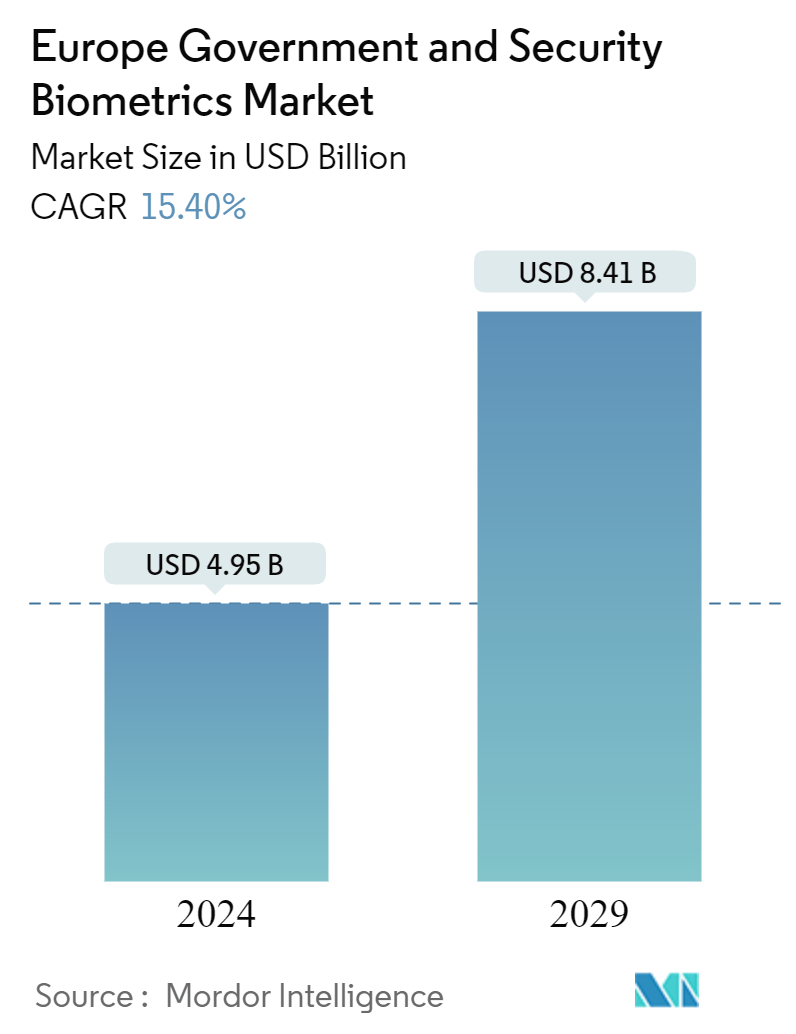Market Size of Europe Government And Security Biometrics Industry

| Study Period | 2019 - 2029 |
| Market Size (2024) | USD 4.95 Billion |
| Market Size (2029) | USD 8.41 Billion |
| CAGR (2024 - 2029) | 15.40 % |
| Fastest Growing Market | Europe |
| Largest Market | Europe |
| Market Concentration | Low |
Major Players
*Disclaimer: Major Players sorted in no particular order |
Europe Government And Security Biometrics Market Analysis
The Europe Government And Security Biometrics Market size is estimated at USD 4.95 billion in 2024, and is expected to reach USD 8.41 billion by 2029, growing at a CAGR of 15.40% during the forecast period (2024-2029).
Biometric security solutions and analytics technologies provide government agencies with unprecedented real-time data identification and verification capabilities, improving security and data understanding. The biometric identification market for government and security purposes is expected to register significant growth due to the increasing security requirements, as well as the growing theft of sensitive data and information.
- Security biometrics have many uses, particularly in digital privacy and security. The development of biometric technology has enabled it to become more accurate, reliable, and easy to integrate, leading to increased utilization of biometrics solutions. The European Union’s new law directive entered force in June 2023 to eliminate discrepancies and consolidate existing regulations. Prum Regulation enables law enforcement agencies to exchange information, including facial biometric data, to facilitate cross-border searches for criminals and suspects.
- Using biometric systems is becoming increasingly prevalent to guarantee a secure and equitable electoral process. These systems provide identification solutions for registration, voting, counting, and identification. Standard identification methods include fingerprint, palm vein, iris, and facial recognition. The UK government announced that its residents would have to present photographic identification when voting in certain elections starting in May 2023 due to the passage of the Elections Act in April 2022. The new rules will require the support of a variety of documents, including passports, driving licenses, biometric immigration IDs, and specific electoral identity cards.
- The growth of the biometrics market is primarily attributed to the increasing use of morphological identifiers (iris, palm vein, fingerprint, and facial recognition scanners), increasing government expenditure on security improvements, and stringent government regulations and modernized identification procedures for voter equality. Additionally, in the face of document fraud, identity theft, terrorism, cybercrime, and changes in regional regulations, new biometrics security solutions are being deployed. The demand for iris recognition is rising due to its distinctive and precise identification capabilities focusing on security and efficiency.
- The potential repercussions of a biometric data breach can be dire, as individuals may be exposed to the risk of fraudulent activities and identity theft, mainly if the information is not adequately safeguarded, thus impeding the development of the market. Furthermore, as with any technology, the biometric systems may be subject to malicious interference, such as spoofing, manipulation, or hacking, which can compromise their effectiveness.
- In May 2023, Europe implemented a regulation prohibiting the implementation of mass facial recognition programs in public spaces and the use of predictive policing algorithms that attempt to identify future criminals using personal data. Additionally, the regulation requires establishing a publicly available database of high-risk artificial intelligence (AI) systems employed by public and government entities to provide European citizens with information on when and how this technology is impacting them.
Europe Government And Security Biometrics Industry Segmentation
Security biometrics is a form of biometrics that, at the most fundamental level, involves measuring biological features such as fingerprints, iris patterns, eye retinal, and other identifiers. This data is then used to create a unique biometric signature that can only be attributed to a single individual. Companies are now beginning to recognize the advantages of biometrics, as they are now being used for various purposes.
The European government and security biometrics market is segmented by type (iris recognition, voice recognition, face recognition, palm print recognition, and fingerprint recognition), application (border safety and immigration, e-passport, national ID, e-visas, voter identification, access control and physical security, mobile identification, authentication/verification, and public services), and country. The market sizes and forecasts are provided in terms of value (USD) for all the above segments.
| By Type | |
| Iris Recognition | |
| Voice Recognition | |
| Face Recognition | |
| Palm Print Recognition | |
| Fingerprint Recognition |
| By Application | |
| Border Safety and Immigration | |
| E-Passport | |
| National ID | |
| E-Visas | |
| Voter Identification | |
| Access Control and Physical Security | |
| Mobile Identification | |
| Authentication/Verification | |
| Public Services |
| By Country | |
| United Kingdom | |
| Germany | |
| France | |
| Spain | |
| Italy | |
| Norway | |
| Sweden |
Europe Government And Security Biometrics Market Size Summary
The European government and security biometrics market is experiencing significant growth, driven by the increasing need for enhanced security measures and the adoption of advanced biometric technologies. These technologies, including fingerprint, iris, palm vein, and facial recognition systems, are being integrated into various government and security applications to improve data identification and verification processes. The market is characterized by a fragmented landscape with numerous players, such as id3 Technologies, IrisGuard Ltd, and Thales Group, who are actively engaging in strategies like product innovation and partnerships to strengthen their market positions. The implementation of new regulations, such as the European Union's Prum Regulation and the UK's Elections Act, underscores the growing importance of biometrics in ensuring secure and equitable processes in areas like voting and cross-border law enforcement.
The demand for biometric solutions is further fueled by the rising concerns over identity theft, cybercrime, and the need for secure identity verification in processes like visa clearance and border control. The market is also witnessing the deployment of biometric systems in airports and public spaces to enhance operational efficiency and security. However, challenges such as the potential for data breaches and malicious interference pose risks to market growth. Regulatory developments, such as the prohibition of mass facial recognition programs and the establishment of databases for high-risk AI systems, reflect the ongoing efforts to balance security needs with privacy concerns. As biometric technologies continue to evolve, their integration into government and security frameworks is expected to expand, offering robust solutions for modern security challenges.
Europe Government And Security Biometrics Market Size - Table of Contents
-
1. MARKET INSIGHTS
-
1.1 Market Overview
-
1.2 Industry Attractiveness - Porter's Five Forces Analysis
-
1.2.1 Bargaining Power of Suppliers
-
1.2.2 Bargaining Power of Consumers
-
1.2.3 Threat of New Entrants
-
1.2.4 Threat of Substitutes
-
1.2.5 Intensity of Competitive Rivalry
-
-
1.3 Impact of COVID-19 on the Europe Government and Security Biometrics Market
-
-
2. MARKET SEGMENTATION
-
2.1 By Type
-
2.1.1 Iris Recognition
-
2.1.2 Voice Recognition
-
2.1.3 Face Recognition
-
2.1.4 Palm Print Recognition
-
2.1.5 Fingerprint Recognition
-
-
2.2 By Application
-
2.2.1 Border Safety and Immigration
-
2.2.2 E-Passport
-
2.2.3 National ID
-
2.2.4 E-Visas
-
2.2.5 Voter Identification
-
2.2.6 Access Control and Physical Security
-
2.2.7 Mobile Identification
-
2.2.8 Authentication/Verification
-
2.2.9 Public Services
-
-
2.3 By Country
-
2.3.1 United Kingdom
-
2.3.2 Germany
-
2.3.3 France
-
2.3.4 Spain
-
2.3.5 Italy
-
2.3.6 Norway
-
2.3.7 Sweden
-
-
Europe Government And Security Biometrics Market Size FAQs
How big is the Europe Government And Security Biometrics Market?
The Europe Government And Security Biometrics Market size is expected to reach USD 4.95 billion in 2024 and grow at a CAGR of 15.40% to reach USD 8.41 billion by 2029.
What is the current Europe Government And Security Biometrics Market size?
In 2024, the Europe Government And Security Biometrics Market size is expected to reach USD 4.95 billion.

